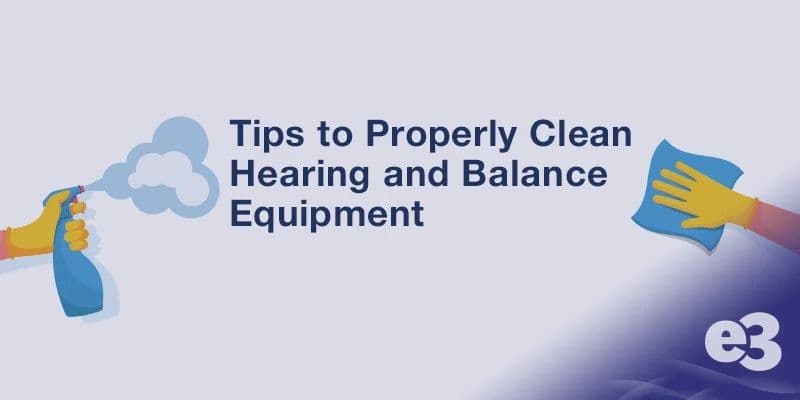Tips to Properly Clean Hearing and Balance Equipment

Hearing and balance assessment equipment is a large investment, so you want to make sure you take care of it and get as many years out of it as possible. You also want to ensure it’s properly disinfected for each patient.
There are many small things that you can easily do yourself to help ensure your equipment lasts and stays sanitized. In addition to having an e3 technician calibrate and provide maintenance on your instruments every year, you should also clean it after each patient appointment.
Read on to see our tips on how to properly clean your hearing and balance equipment.
Be Conservative with Cleaning Products
First thing’s first: You should always disconnect equipment from power before cleaning. This will ensure you don’t harm yourself or the equipment when you clean it. You should also make sure the equipment is completely dry before powering it back on.
Earphone cushions and patient switches should be cleaned between each appointment. The tricky part is not overdoing it. Excessive use of cleaning solutions can create moisture in the headset, which in turn can damage the speakers.
When wiping down equipment and accessories, be mindful not to apply too much solution. One spray or a small dab on a cloth wipe should be plenty. In fact, being more thorough in wiping down the equipment is more important than using excess cleaning fluid. Also, it is wise to remove cushions when cleaning and waiting until they are completely dry to reattach them. If they are damp, the moisture can damage the speakers.
Avoid Alcohol-Based Cleaning Products
While using alcohol-based cleaning solutions may seem like a good way to eliminate bacteria sitting on the surface of your audiology equipment, it can actually damage it. Most audiometric instruments are made of high-quality plastics, which can be cracked or discolored when exposed to excessive amounts of alcohol-based cleaning solutions.
There are many alternatives that are safer and won’t cause harm to your equipment. Warm water and dish soap is a classic solution that is highly effective. You can also try using alcohol-free cleaners. Many non-alcohol-based products contain the active ingredient quaternary ammonia, which is effective against viruses and bacteria.
Check out our alcohol-free cleaners and more infection control products today!
Hydrogen peroxide-based cleaners are also a viable alternative. Quaternary ammonia and hydrogen peroxide are made to disinfect rubber, plastic, silicone, and acrylic, which are common materials in audiology equipment.
Take Special Care of Monitors, Mirrors, and Lenses
When cleaning mirrors and lenses of a VNG system, it’s safest to use soap and water. Due to the infrared coating, it’s not recommended to use any sanitizing wipes for this. If you use disinfecting or sanitizing wipes, the chemicals could damage the infrared coating. Also, be sure not to overclean mirrors and lenses. Doing so can harm the lenses, so be conservative when cleaning.
For monitors, only use products deemed safe for cleaning. Ideally, use a dry, soft, lint-free cloth. A micro-fiber cleaning cloth works best. If you need to use a solution, try a mixture of mild soap and warm water. However, don’t use too much because you want to avoid leaving streaks on the screen. Also, you should unplug the monitor before cleaning and plug it back in when it’s completely dry.
By following these tips, you’ll be able to sanitize your hearing and balance equipment after each appointment without worrying about causing any damage to it. For more information on proper care and cleaning of your equipment, get in touch with your local e3 office or the manufacturer of your instruments. They would be more than happy to provide you with proper instruction on how to care for your equipment so you can get as many years out of it as possible!
